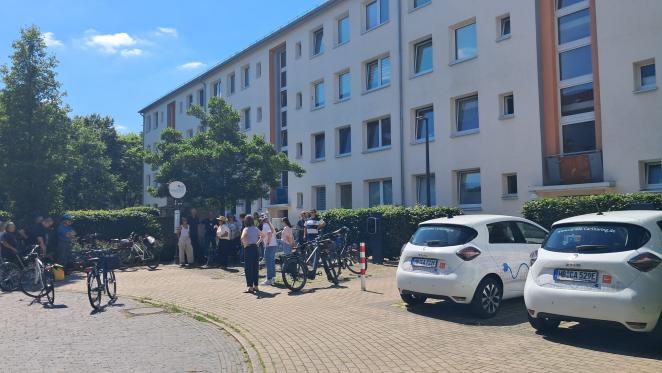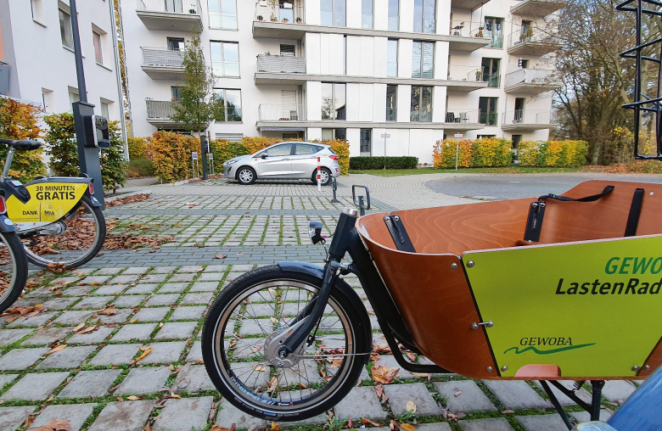Bremen hosted its second mobility management seminar for architects and planners!
The field of architecture and urban planning requires a broad range of knowledge – however, mobility and transport planning is rarely a part of an architects’ training. Nonetheless, working with innovative parking bylaws for new housing developments like the City of Bremen’s mobility bylaw, which places the focus on integrating shared mobility services into new builds requires a broader understanding from professionals working with this bylaw.
That is why the City of Bremen’s transport ministry is working together with the Chamber of Architects within the Interreg North Sea Region “SHARE-North Squared” project to offer a four-part training programme to qualify architects and planners not only in the design of buildings but also to broaden their understanding of mobility services and user mobility behaviour and needs.
Rebecca Karbaumer, Sarah König and Cornelia Cordes from the City of Bremen welcomed 25 architects and planners at the Chamber of Architects in Bremen, to the second session of the four-part training programme. This seminar focused on creating a broader understanding about the different types of shared mobility and their impact on mobility behaviour and the demand for car parking. Participants learned about what is necessary for successfully implementing carsharing into new building sites: from what makes a carsharing service attractive to potential users, site selection criteria, choosing the right number of vehicles as well as technical design components.
Questions such as “What makes a well-implemented carsharing station on private property?” and “Which mistakes should be avoided to ensure user acceptance as well as economic viability of a carsharing service?” were also addressed.

After a half-day of theory in the classroom, the participants were treated to a cycling excursion which took them to practical examples of successfully (and less successfully) implemented carsharing stations in the city to learn firsthand which design specifications they should consider when implementing carsharing into future projects of their own. The cycling tour was guided by Fleming Erdwiens, a representative of the carsharing provider Cambio, which has cooperated with several real-estate developments throughout the city already.

Some of the do's of carsharing:
I. What potential users cannot see is not there. Visibility is a main factor for the (economical) success of a carsharing station. Parking garages are not ideal for carsharing stations! They should be above ground, clearly marked with signage and easy to access.
II. Closed systems should be avoided - sharing services should be available to the broad public and integrated into existing shared mobility systems.
III. A variety of vehicle types makes a carsharing offer attractive. The type vehicles should meet the needs of the users.
IV. Carsharing (and other shared vehicles) should be close by and easy to access - they should be easier to access than the private car.
V. The number of carsharing vehicles should reflect the realistic demand for the services - development sites should start small but plan room for growth.
VI. Communication is everything - buyers, renters, and residents/employees should be informed about the available mobility services before and when they move!

A bit of background
In 2022, the City of Bremen introduced one of the most progressive and innovative parking bylaws in Germany. The most common parking bylaws for new real-estate developments require a developer to plan and implement a specific number of car parking spaces (and perhaps some bicycle parking) for commercial as well as residential properties. This offer of car parking often encourages a higher car-ownership rate (offer-generated demand), high building costs for developers and limited possibilities for development sites that may be dedicated to promoting low-car lifestyles. Bremen’s parking bylaw was converted into a mobility bylaw (the Mobilitäts-Bau-Ortsgesetz) which places the does not focus on the demand for car parking but on the demand for mobility. The most intriguing aspect of this new bylaw is that it primarily focuses on mandatory mobility management measures, fostering the integration of shared mobility and promoting active modes of transport, leaving the construction of car parking spaces a secondary, not the primary, requirement.
You can find more information in the Mobility Guide from Bremen.
Written and pictures by: Rebecca Karbaumer
Co-author: Cornelia Cordes
